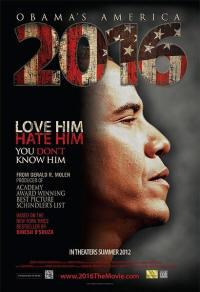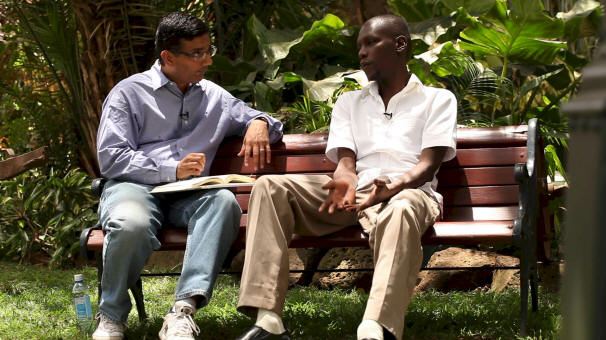2016: Obama’s America
Film Reviewed by Dinesh Sharma
 2016: Obama’s America (2012)
2016: Obama’s America (2012)
In Theaters: Jul 13, 2012 Limited
PG, 1 hr. 29 min.
Documentary, Special Interest
Directed By: Gerald R. Molen , Dinesh D’Souza
Rocky Mountain Pictures
Paranoid and delusional thinking is defined as the generalized distrust and suspicion of others. Individuals suffering from paranoid thinking may sometimes have dreams that are characterized by intuitions and feelings of grandeur bordering on pure fantasy. In art or film, one might give flight to such fantasies or daydreams without disrupting everyday social reality, especially, if you can convince others to assume your version of an alternative social reality, albeit temporarily.
Dinesh D’Souza’s film “2016: Obama’s America” manages to do just this while craftily walking the fine line between partial truths and fiction about the early socialization, family life and political philosophy of the 44th president of the US, Barack Hussein Obama, who also happens to be the first black president of the US with a multiracial, multicultural and multi-religious lineage and genealogy rooted in America, Africa and Indonesia.
Airlift to America (1959-63): There are many historical firsts that President Obama has to his credit, but D’Souza is overwhelmingly concerned with establishing an apparent anti-colonial strain in his worldview acquired from his Kenyan father. The fact that Obama’s father was part of “the airlift to America” sponsored by many civil rights leaders, non-profit organizations and the Kennedy family simply misses D’Souza’s purview. Why? Because it does not fit the anti-American or anti-colonial narrative he imputes to Obama’s father and to the president.
This is a significant ‘sin of omission’ if you’re trying to understand the absentee father’s anti-colonial sentiments that shaped the first black President. Obama’s father was the beneficiary of American goodwill and philanthropy. How could his son think unwell of America? “My story wouldn’t be possible in any other country,” Obama has said repeatedly. But this is all rhetorical, the words of an imposter, according to D’Souza.
Similarly, the fact that Obama’s father wrote news articles praising American society, Hawaiian multiculturalism, and his White Hawaiian hosts are also lost on D’Souza because this would simply crack the colonial or anti-colonial spectacles he wants the audience to try on in a darkened theater.
Instead, D’Souza finds a line in East African Journal in 1965 where Obama’s father suggested 100% taxation to build the newly independent Kenyan economy. This is evidence for the motive for $16 trillion U.S. debt under Obama, a large percentage of which was incurred by the Republican predecessor? But the son has become just like the father, according to D’Souza.
9/11 and Pearl Harbor Attacks: In another blatantly biased claim D’Souza states that the annexation of Hawaii in 1959 was primarily driven by colonization of the natives, which causes resentments even today, while making not a single mention of the fact that native Hawaiians, unlike the mainland US, welcomed newcomers to the islands and married them. Thus, the interracial marriage rates in Hawaii have always been high. The sacrifices of Hawaiians in WW-II in the aftermath of the Pearl Harbor attacks and prior to the annexation are completely missing from this distorted film.
Similarly, D’Souza fails to mention that Obama’s maternal grandfather’s service (Stanley Armour Dunham) in the war also deeply ties Obama to Hawaiian soil and to the memory of the Pearl Harbor attacks, the only other instance when America has been attacked at home prior to September 11, 2011. Why does D’Souza not include any suggestion of these important historical turning points in American life that directly intersect with Obama’s biography? Because he wants you to believe that Obama is not really cut from the same American cloth as other presidents.
According to D’Souza, Obama’s founding father-figures are not Washington, Jefferson and not even Abraham Lincoln, whose career path Obama has imitated, but rather shady group of communist sympathizers, such as, Frank Marshall Davis, Bill Ayers, late Columbia Professor Edward Said, Reverend Jeremiah Wright, and the Harvard Law Professor Robert Unger.
D’Souza tells us at the outset that he is a new immigrant, whose pigmentation is not that different from most African Americans. He reveals this to highlight his debating skills in civil rights. He has questioned many civil rights leaders about the ‘real’ hard evidence of racism, he claims, including a debate with Reverend Jesse Jackson. Mr. Jackson issued a reply that “racism has gone underground” to which D’Souza responded with dismay.
Well, D’Souza has been trying to unearth the hard evidence of racism in American society ever since; his many books and films claim that racism does not exist. It must be quite a feat to invent a career on a revelation that you’ve denied prima facie but continue to gain from financially and politically.
The Indonesian Coup (1965-66): D’Souza peddles Indonesian history from Obama’s autobiography, but curiously fails to reveal the central reason for the disillusionment suffered by Obama’s mother, Stanley Ann Dunham, in Jakarta in the late 1960’s, namely, the nexus of American oil companies and CIA’s deep involvement in the remaking of the fledgling democracy in South East Asia. When Ann Dunham landed in Jakarta, thousands of Chinese had been slaughtered by the Indonesian military in a bloody coup. The U.S. had decided to place their man, General Suharto, in charge of the emerging Islamic democracy.
Clearly, D’Souza commits another significant ‘sin of omission’. Why? Because D’Souza wants you to believe that Ann Dunham was somehow genetically predisposed to “not think well of America” as a liberal and passed this trait onto her son by idealizing his anti-colonial African father.
D’Souza gets Daniel Pipes, the Middle East expert, to state explicitly at the end of the film: “This president does think well of the United States”. Mr. Pipes is the individual who was part of the rumor mill in 2007 during the primaries that Obama had attended a madrasa while living in Indonesia, suggesting that he was a closet Muslim. We don’t get any images of Koranic schools in this film, but there are plenty of fringe theories about Muslim or Islamic nations floating around in the film, such as, the Middle Eastern region might turn into the “United States of Islam”.
It can be argued that Obama’s landmark election in 2008 was partly a reflection of several macro and secular trends:
- Emerging multipolar world as suggested by many internationalists and foreign relations experts;
- Correlated with globalization sped-up by the onset of Internet technology fostered by American firms;
- Direct effect of American decline brought on by the two long wars in Iraq and the AfPak region, as argued by many historians; and
- Obama’s global biography resonated remarkably well to all of the above challenges Americans are facing as we move ahead in the 21st century.
Based on the majority of the published reviews of the film, only D’Souza’s right wing supporters seem to really ‘get’ how this anti-colonial virus may have been passed on from the father to the son, eventually driving an improbable rise to the American presidency to level it once and for all or to make America a dethroned superpower. This is what D’Souza interprets is the real meaning of “transformational change” in the Obama world, where the slogan of “Hope and Change” really means “Bankrupt and Destroy”.
D’Souza’s film further obscures the ‘narrative truth’ with many outright factual errors or ‘sins of commission’, as reported by the Associated Press:
- Blaming Obama for the national debt of $16 trillion but never explaining the doubling of the debt under Republicans in 2008;
- Failing to mention the killing of Osama bin Laden and the escalation of drone strikes in Afghanistan and Pakistan, while accusing Obama of harboring Muslim sympathies; D’Souza ignores the non-partisan polling data which repeatedly indicates Obama has the lowest approval ratings in the Muslim majority nations due to drone attacks;
- Despite the severe trade and economic sanctions against Iran accusing Obama of inaction against the Iranian regime to challenge Israel;
- Removal of Churchill’s loaned bust from the Oval Office was scheduled for a return, not because of Obama’s anti-colonial sentiment;
- Completely unsubstantiated claim that Punahou Academy teaches “oppression studies” without any interviews or written documentation.
Despite these mind-numbing fallacies, there is a perfectly rational way to understand D’Souza’s wild interpretations in film-making. He represents for our times what Richard Hofstadter called a generation ago “the paranoid style of American politics”.
“American politics has often been an arena for angry minds. In recent years, we have seen angry minds at work, mainly among extreme right-wingers, who have now demonstrated, in the Goldwater movement, how much political leverage can be got out of the animosities and passions of a small minority. But, behind this, I believe, there is a style of mind that is far from new, and that is not necessarily right-wing. I call it the paranoid style, simply because no other word adequately evokes the sense of heated exaggeration, suspiciousness, and conspiratorial fantasy that I have in mind.”
As a new immigrant who could have expanded the circle of knowledge, D’Souza disappointingly has hitched his wagon to a regressive trend in American politics, which produces more irrational heat and noise than a reasoned judgment. He has taken one of the more hopeful and inspiring American stories in many generations and turned it into a dark and sinister documentary for political gains.
D’Souza’s paranoid dreams do not align with the American dream and are not good for this country or the world.

Read More AALBC.com Film Reviews

